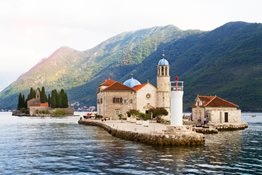
From ancient times, sailors and those who they leave behind on shore have propitiated their deities to keep them safe on the high seas. Every port in the Mediterranean, Adriatic, and Black Sea regions boasts a much-visited church of St. Nicholas or the Virgin Mary, often standing on the ruins of a temple to Neptune or Athena. But perhaps the most intriguing testimony to the enduring belief in divine protection at sea stands - or should we say "floats" - in the middle of the Bay of Kotor near the small Montenegrin village of Perast. It was here in the fifteenth century that a miracle inspired an extraordinary feat of human endeavor: the construction of a man-made island and the Church of Our Lady of the Rocks.
Legend says that two brothers went fishing one day in the Bay of Kotor. One of the brothers, a cripple, spotted an icon of the Madonna and Child on top of a rocky crag sticking out of the sea. He took the icon home and thought no more about it until the next morning he discovered that the icon was no longer to be found and that he had been healed.
The fisherman shared his news with his neighbors, who soon agreed with him that the rock where the icon had been found was holy. The town decided to erect a shrine to the Madonna on the site. They filled the hulls of old ships with rocks and other flotsam and jetsam and sunk them to the bottom of the bay, then piled more rocks on top until a small, man-made island began to form. During this time, a tradition developed for returning sailors to throw rocks onto the island, which only accelerated the formation of the new shrine. By 1452, the shrine was consecrated by the Orthodox Church. In 1630 it was turned over to the Roman Catholic Church, under whose protection it remains today. To visitors ignorant of the story, the church appears to float on the surface of the bay.
The Church of Our Lady of the Rocks today is a moving testimony to the faith of sailors and their loved ones that the sea will be kind and return them to the shores of Perast at their journey’s end. The interior of the church contains more than 2,500 silver votive tablets, each a donation from a grateful sailor, on which he chronicled his perils on the sea and his safe return thanks to Our Lady. The church also contains 68 magnificent paintings by the famous Baroque Montenegrin artist Tripo Kokolja, a native of Perast. Adjacent to the church is a museum where more artifacts connected to the church are housed. One attracts thousands of curious visitors each year: the tapestry known as "Love and Faith," embroidered by a local girl, Jacinta Kunićmijović, who spent 25 years waiting for her sailor lover to return to Perast. The tapestry depicts the Madonna and child and is woven with gold and silver threads on a silk background. What makes it extraordinary is that Jacinta wove strands of her own hair into the tapestry. Legend says she went blind making the tapestry and never saw her lover return.
The modern-day villagers of Perast take their responsibilities to Our Lady of the Rocks very seriously. Each year, on July 22nd, said to be the day on which the original crippled fisherman made his fateful voyage, Perast holds a festive regatta called the Fašinada. They decorate their boats with ribbons and flowers and load them up with as many rocks as they can hold, then sail to the man-made island and throw their rocks into the sea.
Visit Our Lady of the Rocks and learn more about the traditions and culture of Montenegro on Alexander + Roberts’s popular itinerary,
Journey to Croatia and Montenegro, which also visits eight UNESCO World Heritage Sites. Speak to one of our experienced reservation agents about your next trip!